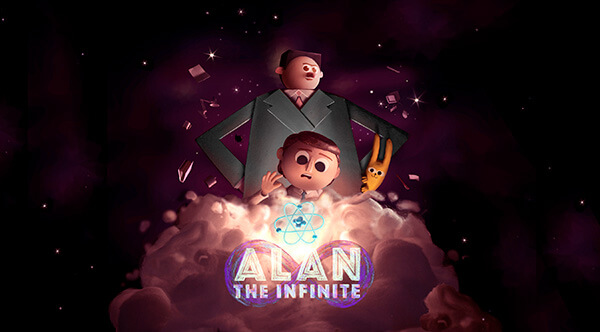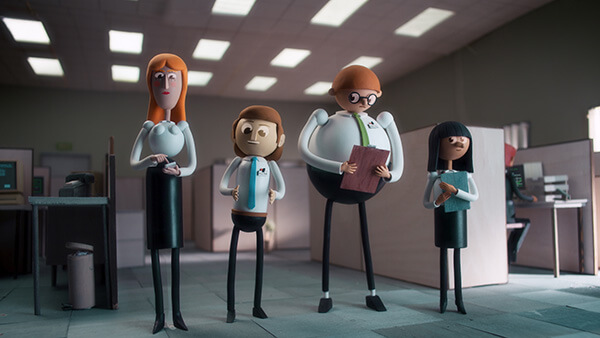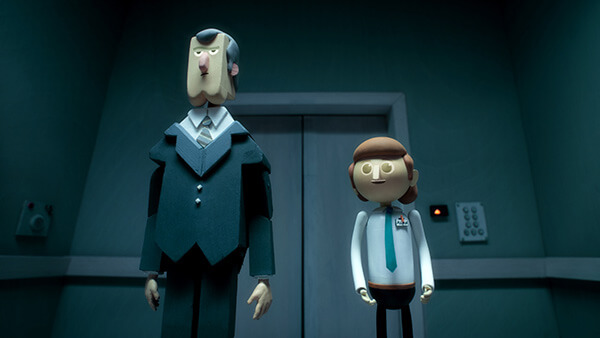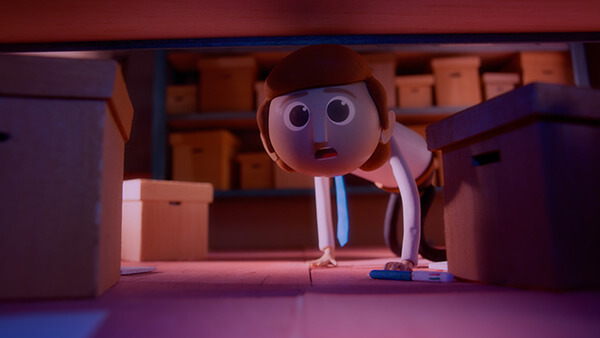Alan the Infinite | Interview with Mikey Please & Dan Ojari
Anything’s possible in the infinite world of Alan! As we join our excited new recruit on his first day at his internship, we are privy to the nervous energy and thoughts that inevitably occur when moving into a new phase of life; will this be a mediocre footnote in the history of Alan, or will it be the most important day of his future career and maybe even life? Step into the incredibly detailed world from stop motion duo Mikey Please and Dan Ojari (Parabella Studios, Robin Robin) as they navigate the nebulous world of office politics, unexplained interdimensional orbs and the complexity of that king of stationery, the lamination machine. As we follow along in this unique coming-of-age tale, we explore the bewildering experience that is your first job and all the pressures that come with it.

Alan the Infinite (Parabella Studios/Blink Industries)
Bringing together their strength for unique narratives, self-aware humor and graphic stop-motion design, the creative partners have teamed up with BLINK INDUSTRIES and an ace team of creatives to create a world with quirky new characters. The film boasts an approach to design that combines an old-school traditional puppet look with their continued use of practical, in-camera effects blended seamlessly with contemporary processes and modern technology such as 3D scanning (read below for more details) that come together to create a bold, unique look.
Alan the Infinite is a tantalizing appetizer to something far more epic, which reflects the directors’ desire to create a longer-form story for the titular hero, with ample opportunity for sci-fi exploration, comedic mishaps and joyous new characters.
Skwigly were lucky enough to get to talk to Mikey and Dan about their respective career paths, the reason behind the stalled project launch and all things Infinite, ahead of the release of their behind-the-scenes video showcasing the work and talent behind the film itself.
I really appreciate the central idea of the film, this notion that we are (particularly in the UK) very much pressured into picking a career and life path very early on and how that can be very difficult and doesn’t work for everyone. Can you talk a bit more about where that idea came from?
Dan Ojari: Thinking back to what it’s like to be 16 or so, there was so much change on the horizon. I think these multiple forks in the road inevitably lead teenagers to feel a huge amount of pressure for many reasons. Not just external pressures of what grades or type of job you’re going to get, but also the internal pressures of what sort of person are you, what friendships will last and what new ones you’ll make. You’re at the very beginning of your journey as an adult and charged with so many possibilities. This theme, which is central to Alan The Infinite, emerged out of digging into our own experiences, alongside the backdrop of Alan being an intern at a workplace that’s obsessed with stopping change. It felt like the perfect way to explore those ever-changing external and internal pressures of a young adult.
Mikey Please: Yes! I think it’s a very common feeling. I acutely remember being sixteen, having to choose just three A-level subjects and feeling the pressure, a kind of existential dread, that this was the paramount fork in the road of destiny. If i got it wrong, my whole life would go wrong. nonsense of course, but that’s the pressure we put on young people. In hindsight, it’s an absurd notion that, somehow, at sixteen, you’re expected to know what you’re going to do for the rest of your life. Since all the atoms in our body are replaced every seven years, i think you should never plan more than seven years ahead, you have no idea who you’re going to be after that. it wasn’t until my second year of Uni (I had gone to study Fine Art sculpture, then hopped ship onto an animatronics course) that I focused in on the world of animation.
Working in the arts and animation is a dream job for most but I’m always super interested to know what people would have done if they hadn’t found animation or if it hadn’t worked out for them. What other careers did you consider?
DO: I was home educated up until the age of 15, so I spent most of my childhood outside of the normal educational system. I guess I was fortunate to have parents who always supported me to pursue what I was interested in, which for me was art. But when I finally joined formal education my love for art got very quickly crushed and so I decided I’d be a scientist instead! I changed courses and loaded up my timetable with science-based courses – I could see a whole exciting sci-fi esc future ahead of me. However, this only lasted a few months until I realised I wasn’t really smart enough to be a scientist, so I went back to art! Now as an adult, I think if I wasn’t working in the arts, I’d love to teach, but probably not the science lessons.

Alan the Infinite (Parabella Studios/Blink Industries)
MP: I had a place to study anthropology at Goldsmiths, which, following a mid-teen crisis, I swapped out for an Art foundation at Bath College. A quick google tells me I could have been a Professor, A museum Director or an Advertising Executive. I like the idea of a professor, but the Indian Jones kind.
I can see you were both quite involved with the physical making of the puppets and sets, it reminds me slightly of George Pal’s work and also Camberwick Green but with a more contemporary and geometric design, what was your vision with the look of this film?
DO: The look of the world sort of started with the character of Alan, I had a collection of wooden dolls and painted wooden folk art and always thought the visual language and materials would make a strong stop motion character. After building a maquette of him, Mikey suggested we go one further and expand the approach to the whole world. In the end, we created a rule that everything must be made from wood (or shiny laminated plastic). We found using simplified wooden shapes and hand painted details, not only looks wonderful but also somehow looks both old fashioned and contemporary, which again was perfect for the themes in the film.
MP: Yes! George and Camberwick were no doubt pinned to our inspiration board. Though for almost all of our projects, when it comes to design, I think our main north star is the world of illustration. I expect that was true for George too! There’s something about the clarity of character and composition in the illustration world that excites us, and the really great stuff, like stop-motion, manages to retain that human fingerprint. Alan the Infinite is our furthest lean into marrying stop-motion with illustration by animating the face in 2D and hopefully striking a balance between precise expression, graphic punchiness and that human touch. I guess that balance of chaos and control has some thematic tie ins to the subject of the film too. But it’d be pontificating to say more than that.
You’ve been sitting on this project for a little while, what caused the delay in release and what made you feel the time was right now?
DO: Firstly we need to say a huge sorry to the cast and crew for not releasing it sooner! We made the film with a phenomenally talented and enthuistic bunch of people, over 5 years ago. However, almost as soon as we finished Alan The Infinite another of our projects Robin Robin was green lit by Aardman and Netflix. So we put the release on hold and never found the right moment to release it, until now!
MP: There’s a complicated answer to that which probably isn’t very interesting. But easiest to say that for years we’ve been scratching our heads as to how to cleverly release it. Then I saw a talk by Kirsten Lepore last October and she advocated not holding things back and letting the universe steer a while. That struck a note and here we are.
You have also mentioned that Alan was intended to have a longer story or even be the linch-pin in an anthology series, do you still have hopes/plans for this?
DO: Yes, the initial idea of Alan The Infinite came from an anthology series I was writing called The Fax Machine Fables, about several strange sci fi stories all set against the backdrop of drab offices. When we started developing Alan The Infinite as a stand alone idea, we used lot’s of the themes and ideas from this anthology to work it into a longer story and initially wrote it as a 10 part mini-series. The incomparable, Over the Garden Wall had just been released and we thought it would pave the way for a whole new coming-of-age mini-series frenzy! However once we finished writing the scripts we realised we’d essentially written a feature, and perhaps that would be the best way to tell the story. So currently the longer story exist in both mini series and feature form.
MP: As Dan says, this is a slice of a much longer story that’s taken a few shapes over the years. When Over The Garden Wall knocked everyone off their seats, we had this kind of naive idea that the world would rapidly embrace that beautiful format, a brilliant mix between longer and shorter form storytelling. But yes, we’re now imagining it as a feature, which probably works better for Alan’s kind of story.

Alan the Infinite (Parabella Studios/Blink Industries)
It feels like we are only just getting to know Alan and the world he lives in, what other ideas do you have for him?
DO: We also wrote a sort of sequel that runs alongside the events of Alan The Infinite but told from Priya’s (his office love interest) point of view. We were heavily inspired by the format of the sci-fi classic Ender’s Game and it’s parallel story sequel – Ender’s Shadow.
MP: But as for Alan, you’ll have to watch the movie/series/series of pamphlets. But safe to say there’s are a lot of laminated layers to Lamin’8.
Side question: just out of curiosity, was the green apple in the opening sequence a nod to Het Klokhuis by Johnny Kelly at all?
DO: Ah! Excellent reference. We love Johnny Kelly, but afraid it wasn’t consciously a direct reference.
MP: We’re such huge fans of Johnny! I’d argue it’s impossible to make contemporary stopmotion without being influenced by him in some way. He’s a truly visionary artist who never stops surprising.
I see that you (Mikey) were the lead compositer on the film. Could you tell me more about how you used 3D tracking to superimpose the 2D animated faces?
MP: Yes, this was a real test of my compositing skills. We had a lot of guidance from Quentin Vien who set up the pipeline. On set, there was a bit of 3D scanning of the puppet heads, measuring the focal lengths from camera to puppet. Then we 3D tracked the footage, applied that to the CG head models and outputted that data as UV matts which then allowed us to animate the 2D in After Effects. It makes me sweaty just thinking about it.

Alan the Infinite (Parabella Studios/Blink Industries)
What are your plans for the film now that it has been released?
DO: We only hope that in some small way it helps unite and inspire the lamination companies of the world to put an end to all change, once and for all.
MP: I’m planning to sit back and scoop up the retrospective Oscar’s for best unproduced pilot. Waiting for that phone to ring. Any. Minute. Now…
For more on the work of Mikey Please and Dan Ojari visit parabellastudios.com

